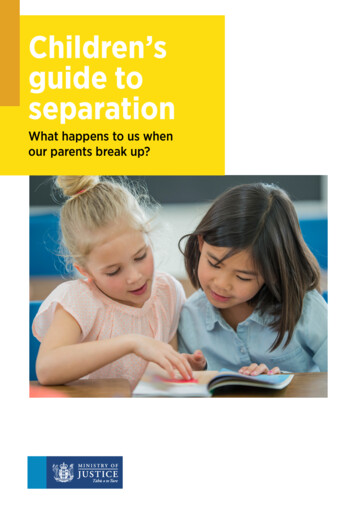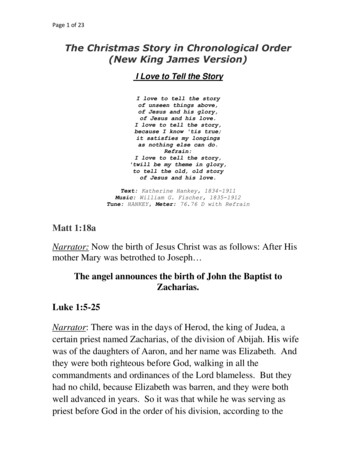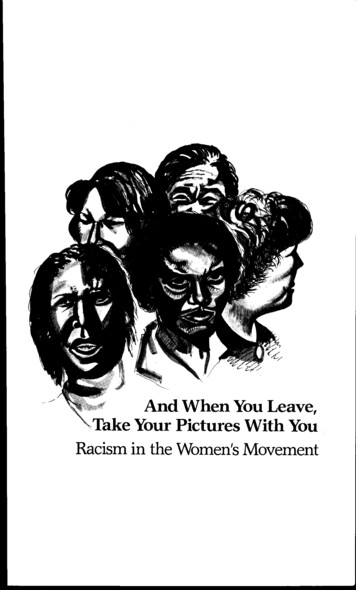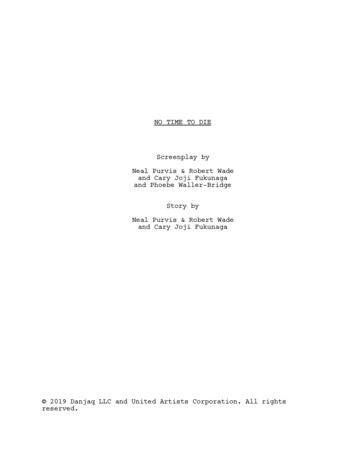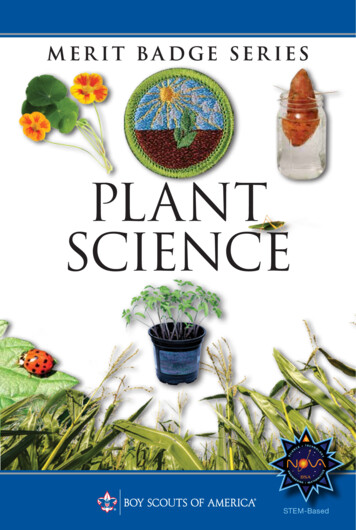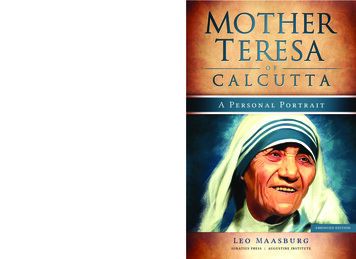
Transcription
Fr. Larry Richards, Author, Be a Man!“Mother Teresa’s daily life can be put in two powerful words: holy daring. Themysterious language spoken between God and the saints is the firm belief thateverything, absolutely everything, is a message of His love. Do I need to say more:tolle, lege (take, read).”Alice von Hildebrand, Author, The Privilege of Being a WomanI gnatius.comAu g u st ine Inst it u t e. or gI G N AT I U S P R E S SAU G U S T I N E I N S T I T U T EFR. LEO MAASBURG, born 1948 in Graz, Austria, studied law, politicalscience, theology, canon law, and missiology in Innsbruck, Oxford and Rome.In 1982, in Fatima, he was ordained a priest. He was a close friend of MotherTeresa for many years as her spiritual advisor, translator, and her confessor.He travelled with her in India, Rome, and on many journeys ranging fromMoscow, to Cuba, to New York. Since 2005 he has been National Directorof the Pontifical Missionary Societies in Austria.Mother Teresa of Calcutta“Msgr. Leo Maasburg gives us such great insight into this very human and very holysaint. Read this book!”M aasburgSHEAMother Teresa’s life sounds like a legend: the Albaniangirl who entered an Irish order to go to India as amissionary and became an “Angel of the Poor” forcountless people.Fr. Leo Maasburg was there as her close companion for manyyears, traveling with her throughout the world and was witnessto countless miracles and incredible little-known occurrences. Inthis personal portrait of the beloved nun, he presents amazingstories about her that most people have never heard, wonderfuland delightful stories about miracles, small and great, that he wasprivileged to experience at Mother Teresa’s side.They all tell of her limitless trust in God’s love, of the way thepower of faith can move mountains, and of hope that can neverdie. These stories reveal a humorous, gifted, wise, and arrestingwoman who has a message of real hope for our time. It’s thelife story of one of the most important women of the twentiethcentury as it has never been told before.ABRIDGED EDI TIONI G N AT I U S P R E S S AU G U S T I N E I N S T I T U T E
1Love at Second SightMSASEPLhe was fascinatingly normal—however extraordinaryher life, her effect on people and her ongoing influence,even today. On the one hand, Mother Teresa exceeded allknown norms, and, on the other hand, she was completelynatural, genuinely “normal”—which was precisely whatmade her so fascinating. During my time with her and at herside, I observed, studied and admired Mother Teresa. Fromthe very first moment, she reminded me of my grandmother.In common with my grandmother Mother Teresa hadnot only hundreds of wrinkles and creases in her face, butalso certain generational characteristics. She was strictand disciplined with herself, but at the same time kindly,considerate and extremely patient with others. She also had thethin, severe lips of many older people, which she occasionally,depending on the situation, pushed forward into a pout; shewould tilt her head a bit to one side and listen to visitors with ahint of skepticism—and yet with great attentiveness.At other moments, again with pursed lips, she would moveher head back and forth, like a wine connoisseur having hisfirst taste of the new vintage—at such moments, those whoknew her sensed that a razor-sharp decision was about tobe made. And finally the pursed lips would disappear, often9
10Mother Teresa of CalcuttaEPLMSAbetween her wrinkled hands and cheeks; her head wouldgrow heavy and Mother Teresa would support it on her toilworn hands, clearly marked by arthritis, and, forgetting hersurroundings, would linger in conversation with her Lord.Here we have arrived at an important feature of MotherTeresa’s personality: she was herself what she demandedagain and again of her Sisters, namely, a “contemplative inthe world.” All her activities and her attention, which seemedto be directed entirely toward the world, concealed anotherimportant part of her nature. The latter—like an iceberg—remained hidden under the surface or, more precisely, wasdirected inward: contemplative; immersed in meditation onGod, His love and His workings in the world. Moreover, shecarried within her a personal secret that none of us knewanything about, a profound mystical suffering that becameknown only after her death: the “dark night of the soul,” anunfulfilled and ardent longing for the close presence of God.On my first visit to Calcutta I was still fairly critical. I wantedto observe in detail in what way Mother Teresa’s spiritualityand piety affected her activities and those of her Sisters. Andso I sat down at a convenient angle from Mother Teresa in thechapel, just to watch how she prayed. She seemed to be totallyabsorbed while, with profound reverence, she sat kneeling onthe floor or on a mat, eyes closed, now and again with herhands pressed into her face.After a while I discovered that a photographer was nervouslypacing up and down outside the chapel door. Evidently hewanted to speak with Mother Teresa but did not dare to goup to her and disturb her. Suddenly a Sister approached himand signaled that he should just approach her. He took off hisshoes and went into the chapel, but hesitated to kneel down
Love at Second Sight11EPLMSAbeside Mother Teresa. Now he will disturb her, I thought—curious as to how she would react.She must have heard or sensed it when he knelt down besideher on the floor, for she looked up and welcomed him witha radiant smile. Her attention now belonged entirely to thephotographer. He presented his business in a few words. Shegave him an answer. He stood up and left the chapel. Beforehe was even outside, Mother Teresa was already completelyand utterly immersed again in prayer.What moved me so much about this short scene was thatMother Teresa gave not even the slightest indication ofdispleasure or annoyance. On the contrary, it was as thoughthe photographer had brought her a present by disturbingher at prayer. Only later did I understand that Jesus Himselfwas so present for Mother Teresa in the people whom shemet that she—coming out of prayer, and thus out of a livelyconversation with Jesus—simply shifted from Jesus to Jesus.One of the truest and most beautiful ways in which MotherTeresa described herself was something that she once saidto a group of journalists. One of the reporters said, “MotherTeresa, what you do is so wonderful!” And she replied, “Youknow, I am only a little pencil in the hand of God, a God whois about to write a love letter to the world.”Mother Teresa meant that we should allow ourselves to beused by God as we ourselves use a pencil: Just as I need apencil to write with, so that I can put on paper what I thinkand want to say, so in a similar way God uses a human beingto express what He thinks and wants to say. God is great andyet humble; He uses us imperfect human beings in order tomanifest His greatness. If we truly want to belong to Him and
12Mother Teresa of Calcuttaserve Him, then we must allow Him to use us in the mannerin which He wants to be proclaimed.But with that I am already anticipating much more of theconclusion than I ought to at the start of this book. So let usbegin once again from the beginning.2EPLMSAI had the privilege of meeting Mother Teresa while I was stilla student. At that time I was working closely with the exiledSlovak bishop Pavol Hnilica, who lived in Rome and supportedthe underground Church in the former Eastern Bloc throughthe charitable organization Pro Fratribus, which he hadfounded. He had become acquainted with Mother Teresa in1964 at the Eucharistic Congress in Bombay (today Mumbai)and probably realized immediately what kind of person shewas. So he urged Pope Paul VI to invite her to come to Romeand finally succeeded. Bishop Hnilica also helped to establishthe first foundation, or house, of Mother Teresa’s Sisters in thesuburb of Tor Fiscale in Rome.Since I was working with the Bishop, I was present whenMother Teresa came for a visit, and also when Bishop Hnilicavisited her at her foundation, San Gregorio, in Rome, butI preferred to stay in the background. At that time I wasinclined to think that I should leave her in peace, especiallysince on those occasions Mother Teresa was besieged bythe great numbers of Czech and Slovak visitors who alwayssurrounded Bishop Hnilica.Rome, of course, was full of interesting celebrities. Iunconsciously placed Mother Teresa in that category as well.But at my very first real encounter with her, she dissolved allmy prejudices. Instead of sitting down with the Bishop and herother visitors and doing all the talking, she brought everybody
Love at Second Sight13EPLMSAinto the chapel, knelt down and remained praying before theMost Blessed Sacrament. She did not want to lead us to herselfand to her work, but rather to the Blessed Sacrament!Ultimately I owe the grace of becoming close to MotherTeresa after I was ordained a priest in 1982, as well as theprivilege of accompanying her time and again on her travelsover the course of several years, to the fact that BishopHnilica had the charism of speaking no English. They wereable to understand each other directly if need be, he in Slovakand she in Croatian (both Slavic languages), but when therewas a more complicated or detailed matter to discuss, theyneeded an interpreter. That’s where I came in, translatingbetween Mother Teresa’s English and Bishop Hnilica’sItalian or German.Once, during one of my first interpreting stints after myordination, Bishop Hnilica went out and I remained alonewith Mother Teresa. I asked her what a newly ordained priestshould do if he felt in his heart that he should go to Russia asa missionary. Her answer came as though shot from a pistol:“He should do what his bishop tells him.”I felt as though she was looking clear through me, and so, tojustify myself, I asked, “But if the bishop doesn’t say anything,what should he do then?”Mother Teresa reflected briefly and replied, “Then heshould do what the Pope tells him.”And that is exactly what happened later: It was indirectlythrough Pope John Paul II that I eventually traveled withMother Teresa, first to Moscow and then to Armenia. Thesecretary of state, Cardinal Angelo Sodano, acting in thePope’s name, gave me the necessary mandate as required bycanon law.
14Mother Teresa of Calcutta2EPLMSAPragmatic and very practical by nature, Mother Teresa hada knack for obtaining assistance and support for her workand her plans through chance meetings—of which there werea countless number. So, on my first lengthy encounter withMother Teresa, once my service as an interpreter for her andmy bishop was completed, not a minute passed before shefound out that I owned a car. She immediately asked me totake three of her Sisters to the airport that afternoon. Andso I found myself that Sunday, at three in the afternoon, inthe parking lot in front of San Gregorio, the Sisters’ housein Rome. Mother Teresa was already standing there and“handed over” her three Sisters to me. Each one carried anopen box on her arm. While loading the trunk I saw thecontents of these boxes: a rolled-up sleeping mat, two foldedsaris, a Bible, a prayer book and a few small personal items.“Are we taking a trip to the countryside?” I asked the Sisterssomewhat teasingly, gesturing toward their light baggage.“No, to the airport,” was their answer.“And what is your destination?” I wanted to know.“Argentina,” said one beaming Sister, whom I could easilyhave taken for a teenager.“And for how long? A week or two?”“Oh, no; surely for at least five to ten years!”Still seeking an explanation for their rather meager baggage,I asked when they had learned about this emigration.“This morning. After the ceremony of our vows, MotherTeresa gave us our new mission! We are so happy!”In the silence that followed I could only compare my priestlyobedience with theirs—the result occupies my thoughts tothis day.
Love at Second Sight15EPLMSAI learned that obedience for consecrated religious extendsmuch, much further than it does for secular priests. The Sisters’total availability for the task they are given by their superiorhas shaped my thinking. Mother Teresa knew exactly whatauthority is really due to anyone; she was quite definitely notsubmissive, but she was very obedient. Never would she haveundertaken something in order to make a good impressionon her superior, or on a bishop or a cardinal. Moreover shecould always distinguish precisely between a command givenby a bishop that was within his competence and one outsidehis competence.Once, when Mother Teresa met Cardinal Franz Königunexpectedly at a Synod of Bishops and he asked her howshe felt among so many bishops, she answered, “You know,Your Eminence, of course I don’t understand everythingthat they say and report here, but I think that it’s perhapssometimes more important to pray for the bishops than tolisten to them.”Although the young Sisters whom I had taken to theairport had received their assignments that same morning,and only then had they learned where they were to travel,they obeyed cheerfully. Later, I often witnessed this kind ofsend-off, which is part of the symbolic way in which the Missionaries of Charity, in a very poignant way, demonstratethe nature of their vows of poverty, chastity, obedience and“full hearted and free service to the poorest of the poor.”After the liturgical ceremony during which the new Sisterstook their vows, they would each place a written copy inMother Teresa’s hands. Then they would go into the sacristy,where Mother Teresa would hand each one of them her assignment. The slip of paper would read: “Dear Sister ,
16Mother Teresa of CalcuttaEPLMSAI am sending you to .” Mother Teresa would fill ineach Sister’s name and the appropriate country by hand. Atthe bottom of each slip of paper she would write: “God blessyou. Mother M. Teresa, MC.”I did not yet know all this when I drove the three Sistersto the airport in Rome. Yet I had already sensed somethingof Mother Teresa’s spirit and of her work. When I got back,I wanted to report to her that her Sisters had left safely. Teaand a few cookies were already waiting for me. And then sheherself came to thank me, or so I first thought. But instead Ialready had my next assignment: “Father, could you drive meto the Vatican tomorrow?”
14 Mother Teresa of Calcutta LE LE 2 Pragmatic and very practical by nature, Mother Teresa had a knack for obtaining assistance and support for her work and her plans through chance meetings—of which there were a countless number. So, on my first lengthy encounter with Mother Teresa, once my service as an interpreter for her and

